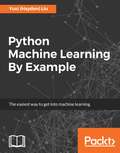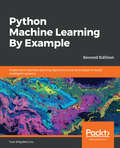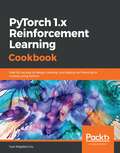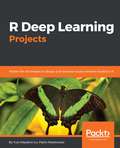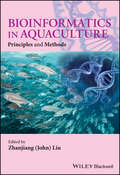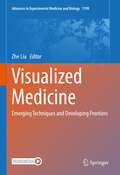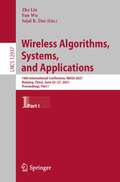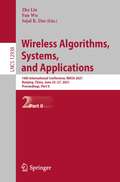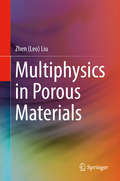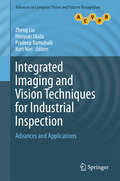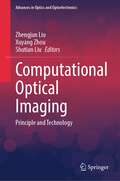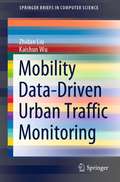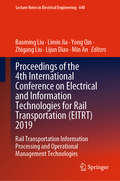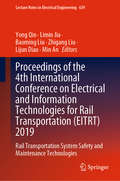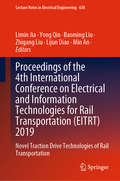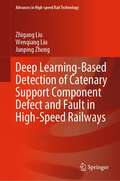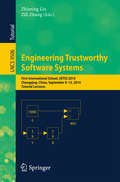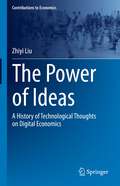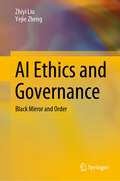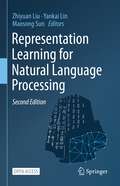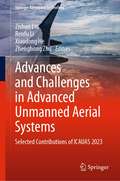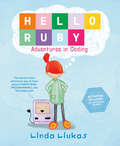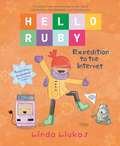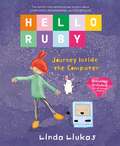- Table View
- List View
Python Machine Learning By Example: Implement Machine Learning Algorithms And Techniques To Build Intelligent Systems, 2nd Edition
by Yuxi Hayden LiuTake tiny steps to enter the big world of data science through this interesting guide About This Book • Learn the fundamentals of machine learning and build your own intelligent applications • Master the art of building your own machine learning systems with this example-based practical guide • Work with important classification and regression algorithms and other machine learning techniques Who This Book Is For This book is for anyone interested in entering the data science stream with machine learning. Basic familiarity with Python is assumed. What You Will Learn • Exploit the power of Python to handle data extraction, manipulation, and exploration techniques • Use Python to visualize data spread across multiple dimensions and extract useful features • Dive deep into the world of analytics to predict situations correctly • Implement machine learning classification and regression algorithms from scratch in Python • Be amazed to see the algorithms in action • Evaluate the performance of a machine learning model and optimize it • Solve interesting real-world problems using machine learning and Python as the journey unfolds In Detail Data science and machine learning are some of the top buzzwords in the technical world today. A resurging interest in machine learning is due to the same factors that have made data mining and Bayesian analysis more popular than ever. This book is your entry point to machine learning. This book starts with an introduction to machine learning and the Python language and shows you how to complete the setup. Moving ahead, you will learn all the important concepts such as, exploratory data analysis, data preprocessing, feature extraction, data visualization and clustering, classification, regression and model performance evaluation. With the help of various projects included, you will find it intriguing to acquire the mechanics of several important machine learning algorithms – they are no more obscure as they thought. Also, you will be guided step by step to build your own models from scratch. Toward the end, you will gather a broad picture of the machine learning ecosystem and best practices of applying machine learning techniques. Through this book, you will learn to tackle data-driven problems and implement your solutions with the powerful yet simple language, Python. Interesting and easy-to-follow examples, to name some, news topic classification, spam email detection, online ad click-through prediction, stock prices forecast, will keep you glued till you reach your goal. Style and approach This book is an enticing journey that starts from the very basics and gradually picks up pace as the story unfolds. Each concept is first succinctly defined in the larger context of things, followed by a detailed explanation of their application. Every concept is explained with the help of a project that solves a real-world problem, and involves hands-on work—giving you a deep insight into the world of machine learning. With simple yet rich language—Python—you will understand and be able to implement the examples with ease.
Python Machine Learning By Example - Second Edition: Implement machine learning algorithms and techniques to build intelligent systems, 2nd Edition
by Yuxi (Hayden) LiuThis book is for Machine Learning Aspirants, Data Analysts, Data Engineers who are highly passionate about Machine Learning and wants to start getting employed in Machine Learning assignments. Prior knowledge of python coding is assumed and basic familiarity with the statistical concept is beneficial although not a mandate
PyTorch 1.0 Reinforcement Learning Cookbook: Over 60 Recipes To Design, Develop, And Deploy Self-learning Ai Models Using Python
by Yuxi (Hayden) LiuMachine learning engineers, data scientists and AI researchers looking for quick solutions to different problems in RL will find the book useful. Prior exposure to machine learning concepts is required, while previous experience with PyTorch will be a bonus.
R Deep Learning Projects: Master the techniques to design and develop neural network models in R
by Yuxi Hayden Liu Pablo Maldonado5 real-world projects to help you master deep learning concepts Key Features Master the different deep learning paradigms and build real-world projects related to text generation, sentiment analysis, fraud detection, and more Get to grips with R's impressive range of Deep Learning libraries and frameworks such as deepnet, MXNetR, Tensorflow, H2O, Keras, and text2vec Practical projects that show you how to implement different neural networks with helpful tips, tricks, and best practices Book Description R is a popular programming language used by statisticians and mathematicians for statistical analysis, and is popularly used for deep learning. Deep Learning, as we all know, is one of the trending topics today, and is finding practical applications in a lot of domains. This book demonstrates end-to-end implementations of five real-world projects on popular topics in deep learning such as handwritten digit recognition, traffic light detection, fraud detection, text generation, and sentiment analysis. You'll learn how to train effective neural networks in R—including convolutional neural networks, recurrent neural networks, and LSTMs—and apply them in practical scenarios. The book also highlights how neural networks can be trained using GPU capabilities. You will use popular R libraries and packages—such as MXNetR, H2O, deepnet, and more—to implement the projects. By the end of this book, you will have a better understanding of deep learning concepts and techniques and how to use them in a practical setting. What you will learn - Instrument Deep Learning models with packages such as deepnet, MXNetR, Tensorflow, H2O, Keras, and text2vec - Apply neural networks to perform handwritten digit recognition using MXNet - Get the knack of CNN models, Neural Network API, Keras, and TensorFlow for traffic sign classification -Implement credit card fraud detection with Autoencoders -Master reconstructing images using variational autoencoders - Wade through sentiment analysis from movie reviews - Run from past to future and vice versa with bidirectional Long Short-Term Memory (LSTM) networks - Understand the applications of Autoencoder Neural Networks in clustering and dimensionality reductionWho this book is for Machine learning professionals and data scientists looking to master deep learning by implementing practical projects in R will find this book a useful resource. A knowledge of R programming and the basic concepts of deep learning is required to get the best out of this book.
Bioinformatics in Aquaculture: Principles and Methods
by Zhanjiang John LiuBioinformatics derives knowledge from computer analysis of biological data. In particular, genomic and transcriptomic datasets are processed, analysed and, whenever possible, associated with experimental results from various sources, to draw structural, organizational, and functional information relevant to biology. Research in bioinformatics includes method development for storage, retrieval, and analysis of the data. Bioinformatics in Aquaculture provides the most up to date reviews of next generation sequencing technologies, their applications in aquaculture, and principles and methodologies for the analysis of genomic and transcriptomic large datasets using bioinformatic methods, algorithm, and databases. The book is unique in providing guidance for the best software packages suitable for various analysis, providing detailed examples of using bioinformatic software and command lines in the context of real world experiments. This book is a vital tool for all those working in genomics, molecular biology, biochemistry and genetics related to aquaculture, and computational and biological sciences.
Visualized Medicine: Emerging Techniques and Developing Frontiers (Advances in Experimental Medicine and Biology #1199)
by Zhe LiuThis book summarizes the recent advancements for visualized medicine in terms of fundamental principles, rapidly emerging techniques and developing frontiers. Especially with the combination of artificial intelligence (AI), medical imaging agents and medical robots, smart medical technologies have been innovated and applied to the clinical uses to serve the fatal human diseases diagnosis, treatment, prognosis and data analysis. This philosophy comprehensively revolutionizes the treatment strategy of human healthcare, and will enable precision medicine and precision surgery further intuitively detectable, smartly analyzable and accurately operational. This book will discuss and conclude: 1) state-of-the-art definition of visualized medicine; 2) advanced techniques and clinical applications of visualized medicine in the past decade; 3) novel frontiers and brand-new technologies, e.g. artificial intelligence (AI), surgical robots, etc. 4) revolutionary impacts on disease diagnosis, treatments and prognosis; 5) future challenges and perspectives.
Wireless Algorithms, Systems, and Applications: 16th International Conference, WASA 2021, Nanjing, China, June 25–27, 2021, Proceedings, Part I (Lecture Notes in Computer Science #12937)
by Zhe Liu Fan Wu Sajal K. DasThe three-volume set LNCS 12937 - 12939 constitutes the proceedings of the 16th International Conference on Wireless Algorithms, Systems, and Applications, WASA 2021, which was held during June 25-27, 2021. The conference took place in Nanjing, China.The 103 full and 57 short papers presented in these proceedings were carefully reviewed and selected from 315 submissions. The following topics are covered in Part I of the set: network protocols, signal processing, wireless telecommunication systems, blockchain, IoT and edge computing, artificial intelligence, computer security, distributed computer systems, machine learning, and others.
Wireless Algorithms, Systems, and Applications: 16th International Conference, WASA 2021, Nanjing, China, June 25–27, 2021, Proceedings, Part II (Lecture Notes in Computer Science #12938)
by Zhe Liu Fan Wu Sajal K. DasThe three-volume set constitutes the proceedings of the 16th International Conference on Wireless Algorithms, Systems, and Applications, WASA 2021, which was held during June 25-27, 2021. The conference took place in Nanjing, China.The 103 full and 57 short papers presented in these proceedings were carefully reviewed and selected from 315 submissions. The contributions in Part II of the set are subdivided into the following topical sections: Scheduling & Optimization II; Security; Data Center Networks and Cloud Computing; Privacy-Aware Computing; Internet of Vehicles; Visual Computing for IoT; Mobile Ad-Hoc Networks.
Multiphysics in Porous Materials
by Zhen Leo LiuThis book summarizes, defines, and contextualizes multiphysics with an emphasis on porous materials. It covers various essential aspects of multiphysics, from history, definition, and scope to mathematical theories, physical mechanisms, and numerical implementations. The emphasis on porous materials maximizes readers’ understanding as these substances are abundant in nature and a common breeding ground of multiphysical phenomena, especially complicated multiphysics. Dr. Liu’s lucid and easy-to-follow presentation serve as a blueprint on the use of multiphysics as a leading edge technique for computer modeling. The contents are organized to facilitate the transition from familiar, monolithic physics such as heat transfer and pore water movement to state-of-the-art applications involving multiphysics, including poroelasticity, thermohydro-mechanical processes, electrokinetics, electromagnetics, fluid dynamics, fluid structure interaction, and electromagnetomechanics. This volume serves as both a general reference and specific treatise for various scientific and engineering disciplines involving multiphysics simulation and porous materials.
Integrated Imaging and Vision Techniques for Industrial Inspection
by Zheng Liu Hiroyuki Ukida Pradeep Ramuhalli Kurt NielThis pioneering text/reference presents a detailed focus on the use of machine vision techniques in industrial inspection applications. An internationally renowned selection of experts provide insights on a range of inspection tasks, drawn from their cutting-edge work in academia and industry, covering practical issues of vision system integration for real-world applications. Topics and features: presents a comprehensive review of state-of-the-art hardware and software tools for machine vision, and the evolution of algorithms for industrial inspection; includes in-depth descriptions of advanced inspection methodologies and machine vision technologies for specific needs; discusses the latest developments and future trends in imaging and vision techniques for industrial inspection tasks; provides a focus on imaging and vision system integration, implementation, and optimization; describes the pitfalls and barriers to developing successful inspection systems for smooth and efficient manufacturing process.
Integrated Imaging and Vision Techniques for Industrial Inspection: Advances and Applications (Advances in Computer Vision and Pattern Recognition)
by Zheng Liu Hiroyuki Ukida Pradeep Ramuhalli Kurt NielThis pioneering text/reference presents a detailed focus on the use of machine vision techniques in industrial inspection applications. An internationally renowned selection of experts provide insights on a range of inspection tasks, drawn from their cutting-edge work in academia and industry, covering practical issues of vision system integration for real-world applications. Topics and features: presents a comprehensive review of state-of-the-art hardware and software tools for machine vision, and the evolution of algorithms for industrial inspection; includes in-depth descriptions of advanced inspection methodologies and machine vision technologies for specific needs; discusses the latest developments and future trends in imaging and vision techniques for industrial inspection tasks; provides a focus on imaging and vision system integration, implementation, and optimization; describes the pitfalls and barriers to developing successful inspection systems for smooth and efficient manufacturing process.
Computational Optical Imaging: Principle and Technology (Advances in Optics and Optoelectronics)
by Zhengjun Liu Xuyang Zhou Shutian LiuThis book highlights a comprehensive introduction to the principles and calculation methods of computational optical imaging. Integrating optical imaging and computing technology to achieve significant performance improvements, computational optical imaging has become an active research field in optics. It has given rise to the emerging of new concepts such as computational imaging, computational measurement and computational photography. As high-performance image detectors make image measurements discrete and digital, images are mostly recorded in the form of discrete data, almost replacing the continuous medium used for pattern recording. Computational optical imaging technology has become an effective way for people to study microscopic imaging. At present, different imaging systems are composed of continuous optical elements such as lenses and prisms or discrete optical elements such as spatial light modulators or digital micro-mirror devices. The current computing technology has permeated all aspects of imaging systems and gradually promotes the digitization of optical imaging systems. This book summarizes the representative work done in this field and introduces the latest results. Computing technology plays an important bridging role between theories of optics and experimental systems, which inspires more comprehensive and in-depth research. It has the advantages of high repeatability, flexibility, strong computing power and low cost. In this multidisciplinary field, researchers in computer science, optics and information science have joined together to extend its depth and breadth. Targeting cutting-edge issues to be solved in computational optics, this book introduces a variety of methods that involve theoretical innovations and technical breakthroughs in imaging resolution, the field of view, imaging speed, and computing speed. It intends to provide a handy reference and technical support for graduate students, researchers and professionals engaged in the study and practice of computational optical imaging.
Mobility Data-Driven Urban Traffic Monitoring (SpringerBriefs in Computer Science)
by Zhidan Liu Kaishun WuThis book introduces the concepts of mobility data and data-driven urban traffic monitoring. A typical framework of mobility data-based urban traffic monitoring is also presented, and it describes the processes of mobility data collection, data processing, traffic modelling, and some practical issues of applying the models for urban traffic monitoring. This book presents three novel mobility data-driven urban traffic monitoring approaches. First, to attack the challenge of mobility data sparsity, the authors propose a compressive sensing-based urban traffic monitoring approach. This solution mines the traffic correlation at the road network scale and exploits the compressive sensing theory to recover traffic conditions of the whole road network from sparse traffic samplings. Second, the authors have compared the traffic estimation performances between linear and nonlinear traffic correlation models and proposed a dynamical non-linear traffic correlation modelling-based urban traffic monitoring approach. To address the challenge of involved huge computation overheads, the approach adapts the traffic modelling and estimations tasks to Apache Spark, a popular parallel computing framework. Third, in addition to mobility data collected by the public transit systems, the authors present a crowdsensing-based urban traffic monitoring approach. The proposal exploits the lightweight mobility data collected from participatory bus riders to recover traffic statuses through careful data processing and analysis. Last but not the least, the book points out some future research directions, which can further improve the accuracy and efficiency of mobility data-driven urban traffic monitoring at large scale.This book targets researchers, computer scientists, and engineers, who are interested in the research areas of intelligent transportation systems (ITS), urban computing, big data analytic, and Internet of Things (IoT). Advanced level students studying these topics benefit from this book as well.
Proceedings of the 4th International Conference on Electrical and Information Technologies for Rail Transportation: Rail Transportation Information Processing and Operational Management Technologies (Lecture Notes in Electrical Engineering #640)
by Zhigang Liu Limin Jia Yong Qin Lijun Diao Min An Baoming LiuThis book reflects the latest research trends, methods and experimental results in the field of electrical and information technologies for rail transportation, which covers abundant state-of-the-art research theories and ideas. As a vital field of research that is highly relevant to current developments in a number of technological domains, the subjects it covered include intelligent computing, information processing, Communication Technology, Automatic Control, etc. The objective of the proceedings is to provide a major interdisciplinary forum for researchers, engineers, academicians as well as industrial professionals to present the most innovative research and development in the field of rail transportation electrical and information technologies. Engineers and researchers in academia, industry, and the government will also explore an insight view of the solutions that combine ideas from multiple disciplines in this field. The volumes serve as an excellent reference work for researchers and graduate students working on rail transportation, electrical and information technologies.
Proceedings of the 4th International Conference on Electrical and Information Technologies for Rail Transportation: Rail Transportation System Safety and Maintenance Technologies (Lecture Notes in Electrical Engineering #639)
by Zhigang Liu Limin Jia Yong Qin Lijun Diao Min An Baoming LiuThis book reflects the latest research trends, methods and experimental results in the field of electrical and information technologies for rail transportation, which covers abundant state-of-the-art research theories and ideas. As a vital field of research that is highly relevant to current developments in a number of technological domains, the subjects it covered include intelligent computing, information processing, Communication Technology, Automatic Control, etc. The objective of the proceedings is to provide a major interdisciplinary forum for researchers, engineers, academicians as well as industrial professionals to present the most innovative research and development in the field of rail transportation electrical and information technologies. Engineers and researchers in academia, industry, and the government will also explore an insight view of the solutions that combine ideas from multiple disciplines in this field. The volumes serve as an excellent reference work for researchers and graduate students working on rail transportation, electrical and information technologies.
Proceedings of the 4th International Conference on Electrical and Information Technologies for Rail Transportation: Novel Traction Drive Technologies of Rail Transportation (Lecture Notes in Electrical Engineering #638)
by Zhigang Liu Limin Jia Yong Qin Lijun Diao Min An Baoming LiuThis book reflects the latest research trends, methods and experimental results in the field of electrical and information technologies for rail transportation, which covers abundant state-of-the-art research theories and ideas. As a vital field of research that is highly relevant to current developments in a number of technological domains, the subjects it covered include intelligent computing, information processing, Communication Technology, Automatic Control, etc. The objective of the proceedings is to provide a major interdisciplinary forum for researchers, engineers, academicians as well as industrial professionals to present the most innovative research and development in the field of rail transportation electrical and information technologies. Engineers and researchers in academia, industry, and the government will also explore an insight view of the solutions that combine ideas from multiple disciplines in this field. The volumes serve as an excellent reference work for researchers and graduate students working on rail transportation, electrical and information technologies.
Deep Learning-Based Detection of Catenary Support Component Defect and Fault in High-Speed Railways (Advances in High-speed Rail Technology)
by Zhigang Liu Wenqiang Liu Junping ZhongThis book focuses on the deep learning technologies and their applications in the catenary detection of high-speed railways. As the only source of power for high-speed trains, the catenary's service performance directly affects the safe operation of high-speed railways. This book systematically shows the latest research results of catenary detection in high-speed railways, especially the detection of catenary support component defect and fault. Some methods or algorithms have been adopted in practical engineering. These methods or algorithms provide important references and help the researcher, scholar, and engineer on pantograph and catenary technology in high-speed railways. Unlike traditional detection methods of catenary support component based on image processing, some advanced methods in the deep learning field, including convolutional neural network, reinforcement learning, generative adversarial network, etc., are adopted and improved in this book. The main contents include the overview of catenary detection of electrified railways, the introduction of some advance of deep learning theories, catenary support components and their characteristics in high-speed railways, the image reprocessing of catenary support components, the positioning of catenary support components, the detection of defect and fault, the detection based on 3D point cloud, etc.
Engineering Trustworthy Software Systems
by Zhiming Liu Zili ZhangThis volume contains the lecture notes of the five coursesand one seminar given at the School on Engineering Trustworthy Software Systems(SETSS 2014), held in September 2014 at Southwest University in Chongqing,China. The material is useful for postgraduate students,researchers, academics and industrial engineers who are interested in thetheory and practice of methods and tools for the design and programming oftrustworthy software systems. The common themes of the courses include thedesign and use of theories, techniques and tools for software specification andmodeling, analysis and verification. The courses cover sequential programming,component- and object software, hybrid systems and cyber-physical systems withchallenges of termination, security, safety, security, fault-tolerance andreal-time requirements. The techniques include model checking, correctness byconstruction through refinement and model transformations, synthesis andcomputer algebra.
The Power of Ideas: A History of Technological Thoughts on Digital Economics (Contributions to Economics)
by Zhiyi LiuAs the first academic monograph that a Chinese scholar discusses the histories of thoughts and ideas related to the development of digital economics, this book aims to make research from the perspective of the history of ideas and discuss the ideas influencing the development of digital economics and the evolution of related theories and thoughts with the methodology of interdisciplinary research.The human society is in the stage of major historic transition and enters the digital world with the main goal of developing the artificial world. In this world, the development of digital economics is significantly characterized by the deep interaction between the real and the virtual worlds, while the key triggering this paradigm reform is the evolution of ideas since the modern times. While involving the field of computer, these thoughts are also related to the fields of philosophy, ethics, communication and economics. Therefore, the results of the research on the history of ideas related to digital economics are required to really understand the depth of this discipline. If computationalism is the most important paradigm evolution of natural science, the most important paradigm evolution of social science is interdisciplinary complex science. In the meantime, this book is the most significant in understanding the nature of paradigm evolution related to the development of digital economics from the perspective of complex science and interdisciplinary systematic researches.Digital economics is in the foundation-laying phase, while this book mainly aims to historically narrate the thoughts of this discipline and hopes that readers can understand the influence of ideas in the old era on shaping the disciplines in the new era while exploring this new discipline. The construction of digital economics is a process of evolution. This book will be helpful to understand the underlying logic of the ideas constructed by the thinkers in different fields.
AI Ethics and Governance: Black Mirror and Order
by Zhiyi Liu Yejie ZhengThis book deeply analyzes the theoretical roots of the development of global artificial intelligence ethics and AI governance, the ethical issues in AI application scenarios, and the discussion of artificial intelligence governance issues from a global perspective. From the perspective of knowledge, the book includes not only the metaphysical research of traditional Western ethics, but also the interpretation of AI-related practical cases and international policies. The purpose of this book is not only to study AI ethics and governance issues academically, but to seek a path to solve problems in the real world. It is a very meaningful monograph in both academic theory and reality. This book responds to the implementation of China's digital economy governance and other topics. It is a cutting-edge academic monograph that combines industry, policy, and thought.In this book, the author not only discusses the humanities thoughts such as ethics, political economy, philosophy, and sociology, but also involves computer science, biology, and medicine and other science and engineering disciplines, effectively using interdisciplinary thinking as readers clarify how to explore ethical consensus and establish smart social governance rules in the era of artificial intelligence, so as to provide the most comprehensive and unique scientific and technological insights for smart economy participants, related practitioners in the artificial intelligence industry, and government policy makers. For academia, this is a representative book of Chinese scholars' systematic thinking on AI ethical propositions from a global perspective. For the industry, this is a book that understands the policies and ethical propositions faced by the development of AI industry. An important reference book, for policy makers, this is a monograph for understanding how policies in the AI industry make decisions that conform to AI industry practices and people's moral order.
Representation Learning for Natural Language Processing
by Zhiyuan Liu Yankai Lin Maosong SunThis book provides an overview of the recent advances in representation learning theory, algorithms, and applications for natural language processing (NLP), ranging from word embeddings to pre-trained language models. It is divided into four parts. Part I presents the representation learning techniques for multiple language entries, including words, sentences and documents, as well as pre-training techniques. Part II then introduces the related representation techniques to NLP, including graphs, cross-modal entries, and robustness. Part III then introduces the representation techniques for the knowledge that are closely related to NLP, including entity-based world knowledge, sememe-based linguistic knowledge, legal domain knowledge and biomedical domain knowledge. Lastly, Part IV discusses the remaining challenges and future research directions.The theories and algorithms of representation learning presented can also benefit other related domains such as machine learning, social network analysis, semantic Web, information retrieval, data mining and computational biology. This book is intended for advanced undergraduate and graduate students, post-doctoral fellows, researchers, lecturers, and industrial engineers, as well as anyone interested in representation learning and natural language processing.As compared to the first edition, the second edition (1) provides a more detailed introduction to representation learning in Chapter 1; (2) adds four new chapters to introduce pre-trained language models, robust representation learning, legal knowledge representation learning and biomedical knowledge representation learning; (3) updates recent advances in representation learning in all chapters; and (4) corrects some errors in the first edition. The new contents will be approximately 50%+ compared to the first edition. This is an open access book.
Advances and Challenges in Advanced Unmanned Aerial Systems: Selected Contributions of ICAUAS 2023 (Springer Aerospace Technology)
by Zishun Liu Renfu Li Xiaodong He Zhenghong ZhuThis book offers a comprehensive overview of the latest developments in unmanned aerial systems (UAS) technology and their potential applications. It covers a broad spectrum of topics related to UAS, such as Autonomy and Control, Flight Dynamic and Control, Communication and Navigation, Sensing and Perception, Design and Simulation, and Materials and Mechanics. The book is targeted toward a technical audience, including researchers, engineers, and practitioners working in the field of unmanned aerial systems. It provides an in-depth and detailed treatment of the subject matter, offering thorough discussions of the underlying principles and technical details of UAS technology.
Hello Ruby: Adventures in Coding (Hello Ruby #1)
by Linda Liukas"Hello Ruby is half picture book and half activity book rolled into one adorable package. It introduces programming without requiring a computer at all. The point of the book isn't to teach you a programming language, but programming concepts." --GeekMom.comMeet Ruby--a small girl with a huge imagination, and the determination to solve any puzzle. As Ruby stomps around her world making new friends, including the Wise Snow Leopard, the Friendly Foxes, and the Messy Robots, kids will be introduced to the fundamentals of computational thinking, like how to break big problems into small ones, create step-by-step plans, look for patterns and think outside the box through storytelling. Then, these basic concepts at the core of coding and programming will be reinforced through fun playful exercises and activities that encourage exploration and creativity. In Ruby's world anything is possible if you put your mind to it.
Hello Ruby: Expedition to the Internet (Hello Ruby #3)
by Linda LiukasWelcome back to the world's most whimsical way to learn about technology and coding in Hello Ruby: Expedition to the Internet, as Linda Liukas, a programming superstar, teaches kids all about the internet through storytelling and imaginative activities.What exactly is the Internet? Is it a cloud? A network of wires? How does the information travel online? Learn all this and more with Ruby!In Ruby’s world anything is possible if you put your mind to it—even building the Internet out of snow! But before you can build something, you need to understand what it is and how it works. Join Ruby and her friends in their quest to build the most amazing Snow Internet ever, while learning real life facts along the way. Then, future kid coders can put their knowledge and imaginations to the test with the fun and creative exercises included in the activity book section.
Hello Ruby: Journey Inside the Computer (Hello Ruby #2)
by Linda LiukasWhat exactly is a computer? How does it work? What is it made of? Learn all this and more with Ruby!In Ruby's world anything is possible if you put your mind to it—even fixing her father's broken computer! Join Ruby and her new friend, Mouse, on an imaginative journey through the insides of a computer in search of the missing Cursor. From bits and logic gates to computer hardware, in Journey Inside the Computer, Ruby (and her readers!) will learn the basic elements of the machines that power our world. Then future kid coders can put their knowledge and imaginations to work with fun activities. Praise for Linda Liukas and the Hello Ruby series:"[Linda Liukas] wants kids to understand and embrace basic computer logic, so that they later formulate code in the same effortless and creative way they build structures with LEGO." —The Wall Street Journal"Hello Ruby by Linda Liukas is half picture book and half activity book rolled into one adorable package. What I love about it is that it introduces programming without requiring a computer at all." —GeekMom.com
